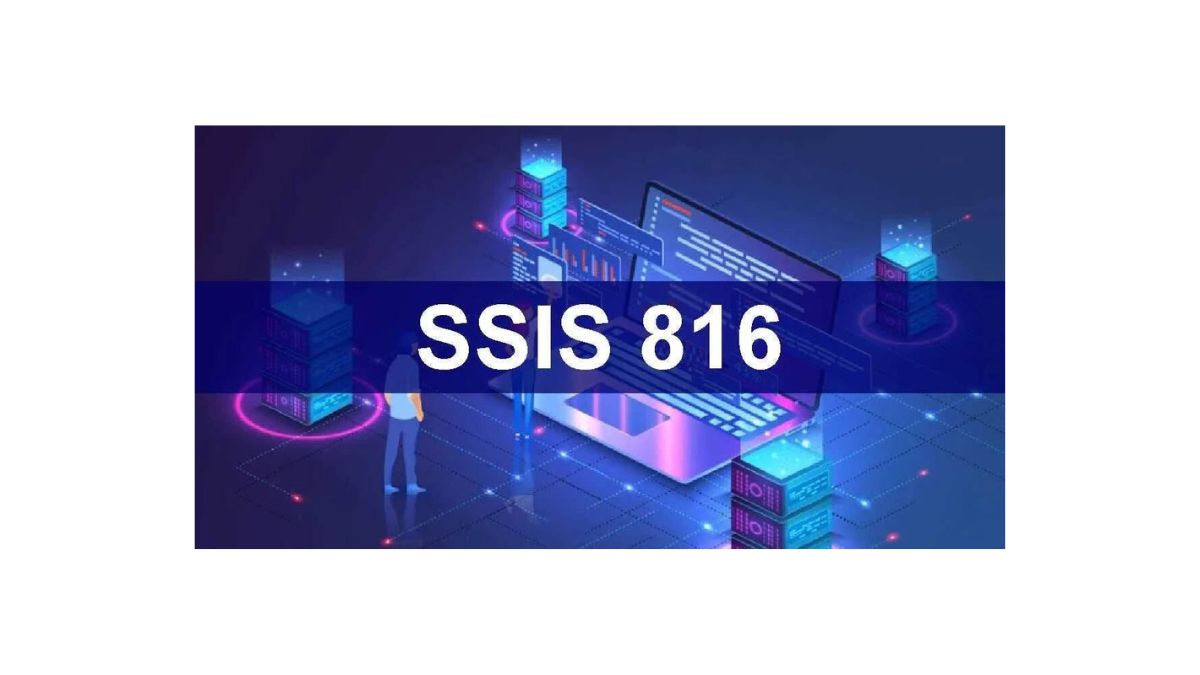Welcome to the exciting world of data integration, where information flows seamlessly and unlocks endless possibilities for businesses! In this digital era, the ability to efficiently merge, transform, and manage data is paramount. And at the forefront of this technological revolution stands SSIS-816 – a powerhouse tool designed to streamline your data integration processes like never before.
The Evolution of SSIS-816
Data integration has come a long way, and the evolution of SSIS-816 is a testament to that progress. From its humble beginnings to its current state-of-the-art capabilities, SSIS-816 has continually adapted to meet the ever-changing needs of data integration. With each iteration, new features and enhancements have been introduced to streamline processes and improve efficiency.
The latest version of SSIS-816 builds upon this foundation by offering even more advanced functionalities and integrations. It provides users with an intuitive interface that simplifies complex data tasks, making it easier than ever to manipulate and transform data in real-time. The flexibility and scalability of SSIS-816 make it a valuable tool for businesses looking to stay ahead in today’s data-driven world.
As technology continues to evolve, so too will SSIS-816, ensuring that it remains at the forefront of data integration solutions. Its innovative approach sets the standard for what is possible in streamlining workflows and maximizing productivity for organizations of all sizes.
Key Features of SSIS-816
SSIS-816, the latest version of SQL Server Integration Services (SSIS), comes packed with a range of key features that make data integration smoother and more efficient than ever before.
One standout feature is its enhanced data flow task performance, allowing for faster processing of large volumes of data. This means quicker execution times and improved overall productivity for users.
Another notable feature is the updated control flow tasks, providing users with more flexibility and control over their data workflows. With new task options and configurations, SSIS-816 enables users to customize their integration processes to suit their specific needs.
Moreover, SSIS-816 offers improved connectivity options with various data sources and destinations. This ensures seamless integration across different platforms and systems, making it easier to consolidate and analyze data from multiple sources.
In addition, SSIS-816 introduces advanced error handling capabilities, enabling users to identify issues quickly and troubleshoot them efficiently. By minimizing errors during integration processes, businesses can maintain accurate and reliable data for informed decision-making.
Benefits of Using SSIS-816 for Data Integration
One of the key benefits of using SSIS-816 for data integration is its powerful ETL (Extract, Transform, Load) capabilities. This tool allows for seamless extraction of data from various sources, transforming it as needed, and loading it into the desired destination.
SSIS-816 offers a user-friendly interface that enables even non-technical users to create complex data integration workflows with ease. The drag-and-drop functionality makes designing and implementing data pipelines straightforward and efficient.
With SSIS-816’s robust scheduling and monitoring features, users can automate their data integration processes and ensure timely execution without manual intervention. This automation saves time and reduces the risk of errors in handling large volumes of data.
Furthermore, SSIS-816 provides extensive connectivity options to interact with a wide range of databases, cloud services, and applications. This flexibility allows organizations to integrate diverse datasets seamlessly across different platforms for comprehensive analytics and decision-making purposes.
Case Studies: Real-Life Examples of Successful Data Integration with SSIS-816
Data integration is not just a theoretical concept; it’s a powerful tool that can drive real-world results. Let’s dive into some case studies that showcase the success of using SSIS-816 for data integration.
In one instance, a large healthcare organization implemented SSIS-816 to streamline their patient data management process. By automating data transfers and cleaning up inconsistencies, they were able to improve operational efficiency and provide better patient care.
Another example comes from a retail company that utilized SSIS-816 to integrate sales data from various sources. This led to improved inventory management, targeted marketing campaigns, and ultimately increased sales revenue.
A financial institution also saw significant benefits by implementing SSIS-816 for integrating customer transaction data. This enabled them to make more informed decisions, reduce risk exposure, and enhance regulatory compliance efforts.
These case studies highlight the tangible impact of using SSIS-816 for efficient and effective data integration solutions in diverse industries.
How to Get Started with SSIS-816
To get started with SSIS-816, the first step is to download and install the software on your system. Make sure you have the necessary permissions and access rights before proceeding with the installation process.
Once installed, familiarize yourself with the user interface of SSIS-816 by exploring its different features and functionalities. Take some time to read through the documentation provided to gain a better understanding of how to use the tool effectively.
Next, start by creating a new project in SSIS-816 and begin defining your data integration tasks. You can use various tools within SSIS-816 to extract, transform, and load data from different sources into your destination systems.
As you work on your data integration tasks, don’t hesitate to reach out for help or consult online resources for guidance. Learning by doing is often one of the best ways to master a new tool like SSIS-816.
The Future of Data Integration and the Role of SSIS-816
As technology continues to advance at a rapid pace, the future of data integration is becoming increasingly sophisticated. SSIS-816 is at the forefront of this evolution, offering powerful features and capabilities to streamline the process of integrating data across various systems and platforms.
With its intuitive interface and robust functionality, SSIS-816 allows organizations to efficiently manage their data integration tasks with ease. From extracting and transforming data to loading it into target systems, SSIS-816 provides a comprehensive solution for all data integration needs.
As companies strive to harness the power of big data and analytics, tools like SSIS-816 will play a crucial role in ensuring seamless connectivity between disparate datasets. By automating processes and enabling real-time data processing, SSIS-816 empowers businesses to make informed decisions based on accurate and up-to-date information.
Looking ahead, the role of SSIS-816 in shaping the future of data integration cannot be understated. As technology continues to evolve, so too will the capabilities of tools like SSIS-816, paving the way for even more efficient and advanced solutions in the realm of data integration.
Conclusion
As we wrap up our exploration of the future of data integration and the powerful features of SSIS-816, it’s clear that technology continues to evolve at a rapid pace. The possibilities for seamless data integration are expanding, opening up new opportunities for businesses to streamline their processes and make more informed decisions.
SSIS-816 is paving the way for efficient data integration solutions that can handle large volumes of information with ease. By harnessing its key features, organizations can achieve improved productivity, accuracy, and insights from their data.
Looking ahead, the role of SSIS-816 in shaping the future of data integration is promising. As businesses continue to prioritize data-driven strategies, tools like SSIS-816 will play a crucial part in enabling them to stay competitive in an increasingly digital landscape.
Stay tuned as we witness how SSIS-816 transforms the way companies approach data integration challenges and unlocks new possibilities for innovation and growth.
FAQs
Q: What is SSIS-816?
A: SSIS-816 stands for SQL Server Integration Services 2016, which is a powerful data integration tool developed by Microsoft.
Q: How can I benefit from using SSIS-816 for data integration?
A: By leveraging the key features of SSIS-816 such as enhanced performance, scalability, and flexibility, you can streamline your data integration processes and improve overall efficiency.
Q: Can you provide examples of successful data integration with SSIS-816?
A: Yes! Real-life case studies have demonstrated how organizations across various industries have achieved seamless data integration and transformation using SSIS-816.
As we navigate through the ever-evolving landscape of data integration, it becomes increasingly clear that tools like SSIS-816 play a crucial role in helping businesses harness the power of their data. By embracing innovative features and best practices in data management, organizations can unlock new opportunities for growth and success in the digital era. Stay ahead of the curve by exploring the future of data integration with SSIS-816 today!










